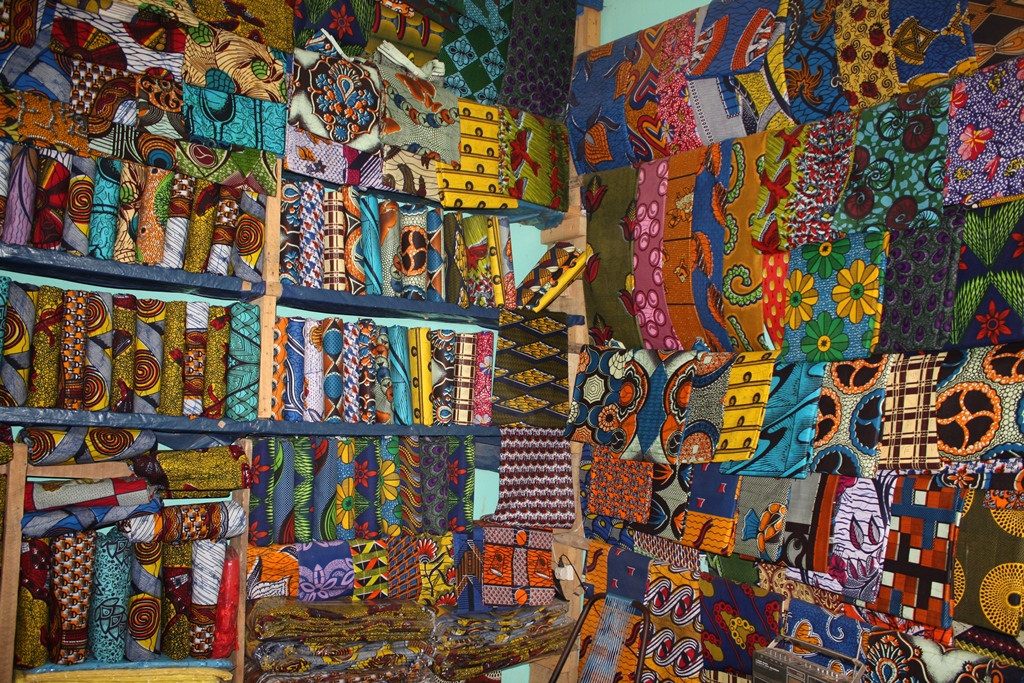
By Alexander Sarlay – Own work, CC BY-SA 4.0, Created: 26 August 2009 , Uploaded: 2 September 2013 https://commons.wikimedia.org/w/index.php?curid=5153433
African fabric prints are more than just textiles; they are vibrant expressions of culture, history, and identity. Each pattern and color combination tells a story, often reflecting the traditions, beliefs, and social status of the people who wear them. From the intricate designs of Kente cloth to the bold patterns of Ankara, African fabrics have inspired fashion worldwide while maintaining their rich cultural significance. In this blog post, we will explore 31 African fabric prints and their meanings, providing a deeper appreciation for these beautiful textiles.
1. Ankara
Known for its bright, bold patterns and vibrant colors, Ankara fabric is synonymous with African fashion. Originally inspired by Indonesian batik, Ankara has become a staple in West African clothing. Each design in Ankara fabric can symbolize different messages, from social status to proverbs, and is often used to communicate important events, place, things or sentiments.
2. Kente
Originating from the Ashanti Kingdom in Ghana, Kente cloth is a symbol of royalty, history, and ethics. The intricate patterns and vibrant colors each hold specific meanings. For example, yellow represents fertility, green signifies renewal, and black symbolizes maturity. The designs are often used in ceremonies and represent a person’s life and status.
3. Kitenge
Common in East Africa, Kitenge (or Chitenge) fabric is known for its versatility and bright, colorful patterns. Kitenge is used in various forms, from everyday clothing to special occasions. The designs often carry social and political messages, with each pattern telling a story or representing a piece of cultural heritage.
4. Dashiki
The Dashiki, popular in West Africa, is a colorful garment worn during cultural celebrations and significant events. The patterns on a Dashiki symbolize unity and African heritage. The garment’s design, featuring bold colors and intricate patterns, often reflects African pride and social status.
5. Adire
Adire is a traditional Nigerian fabric known for its indigo-dyed patterns. Created by the Yoruba people, Adire uses resist-dyeing techniques to produce unique designs. Each pattern has its meaning, often related to Yoruba proverbs and cultural stories. The fabric represents creativity and cultural identity.
6. Aso Oke
Aso Oke is a hand-woven fabric from the Yoruba people of Nigeria, typically used for special occasions like weddings. The fabric’s patterns and colors are symbolic. For instance, blue signifies peace and harmony, while red represents life and strength. Aso Oke is often worn to convey wealth, elegance, and cultural pride.
7. Shweshwe
Shweshwe fabric is a cotton cloth known for its intricate geometric patterns and bright colors, primarily used in South Africa. The fabric is often used in traditional ceremonies and symbolizes cultural heritage. Each design is distinctive, representing different regions and traditions within the country.
8. Bogolanfini (Mud Cloth)
Originating from Mali, Bogolanfini, or Mud Cloth, is a hand-dyed fabric made using fermented mud. Each symbol and pattern in Mud Cloth has a specific meaning, often related to historical events, social status, or mythological stories. The fabric is a powerful medium for storytelling and cultural expression. It is used in clothing, home decor, and ceremonial attire.
9. Batik
While Batik is originally from Indonesia, it has been widely adopted and adapted across Africa. The wax-resist dyeing technique creates intricate patterns and vibrant colors. In Africa, Batik patterns often symbolize local flora, fauna, and folklore, with each design telling a unique story.
10. Fugu (Batakari)
Fugu, also known as Batakari, is a traditional hand-woven fabric from Northern Ghana. It is often worn by men during significant cultural events. The fabric’s patterns and designs can signify social status, power, and community identity. Fugu is valued for its durability and cultural significance.
11. Ntoma
Ntoma is a general term for cloth in Ghana, often referring to wax prints and other fabrics. These prints are not just for aesthetic purposes; they carry messages and stories. The designs can represent various themes, from political statements to social commentary, reflecting the wearer’s beliefs and status.
12. Kikoy
Kikoy fabric, popular in East Africa, especially Kenya, is known for its vibrant stripes and soft texture. Traditionally used as sarongs, Kikoy patterns are simple yet meaningful, often representing the coastal cultures of the region. The fabric symbolizes relaxation, comfort, and the vibrant coastal lifestyle.
13. Khanga
Khanga fabric from East Africa, particularly Tanzania and Kenya, is known for its bold colors and printed messages, often in Swahili. These messages can be proverbs, political statements, or personal expressions. The Khanga is a versatile garment used in daily life and special occasions, symbolizing communication and cultural identity.
14. Baoule
Baoule cloth is a strip-woven fabric from Côte d’Ivoire, created by the Baoule people. The detailed patterns and bold colors are woven into narrow strips and then sewn together. Each design holds cultural significance, often representing local proverbs, historical events, or social status.
15. Lamba Mpanjaka
Lamba Mpanjaka is a royal silk cloth from Madagascar, traditionally worn by royalty and nobility. The fabric’s patterns and colors are rich in symbolism, often representing the wearer’s rank, heritage, and power. Lamba Mpanjaka is highly valued for its beauty and cultural importance.
16. Kuba Cloth
Kuba cloth is a textile made from raffia palm leaves, handwoven by the Kuba people of the Democratic Republic of Congo. It is characterized by its geometric patterns and rich textures. The patterns on Kuba cloth are highly symbolic, often representing social status, family lineage, and historical events. The designs can be abstract, with each shape and line carrying specific cultural significance. Depending on fabric color used, represents wisdom, maturity, purity and peace.
17. Bazin
Bazin is a type of shiny cotton fabric, popular in West Africa, particularly in Mali and Senegal. It is often used for making elegant garments for special occasions. The fabric’s patterns and sheen symbolize luxury, wealth, and celebration, making it a staple in African festive attire.
18. Ewe Kente
Ewe Kente, originating from the Ewe people of Ghana and Togo, is similar to Ashanti Kente but with distinct patterns and colors. Each design represents various proverbs, historical events, and philosophical concepts. Ewe Kente is often used during significant cultural ceremonies, symbolizing identity, and heritage.
19. Ukara
Ukara is a traditional Igbo fabric from Nigeria, used in masquerades and cultural festivals. The fabric features intricate designs made using the resist-dyeing technique. Each pattern holds symbolic meanings, often linked to Igbo mythology and cosmology.
20. Akwete Cloth
Akwete cloth is a traditional handwoven textile made by the Igbo people of Nigeria. It is known for its intricate patterns and vibrant colors. The patterns on Akwete cloth often represent different aspects of Igbo culture and beliefs. Common motifs include natural elements like animals, plants, and rivers, symbolizing life, fertility, and the environment. See how Akwete cloth looks like.
21. Ndop
Ndop is a traditional fabric from Cameroon, created by the Bamileke people. It features geometric patterns and is dyed using natural indigo. Ndop cloth is used in various cultural ceremonies, symbolizing wealth, power, and social status.
22. Kanga
Similar to Khanga, Kanga fabric from East Africa features vibrant colors and Swahili inscriptions. The messages printed on Kanga often convey personal thoughts, social commentary, or political statements. It is widely used in daily life and special occasions, reflecting the wearer’s sentiments and identity.
23. Damask
African Damask, popular in countries like Nigeria, Senegal, and Guinea, is known for its glossy surface and elaborate patterns. This fabric is often used for making traditional garments for celebrations and significant events, symbolizing luxury, elegance, and cultural pride.
24. Indigo Prints
Indigo prints dyeing is one of the oldest textile traditions, with a rich history in West Africa, especially among the Yoruba people of Nigeria, the Dogon of Mali, and various tribes in Senegal and Ghana. Indigo-dyed textiles are highly valued and often used in ceremonies, rituals, and as symbols of prestige. In many African cultures, indigo is associated with spiritual protection and is believed to ward off evil spirits. Reflects the healing power of nature and community. In some parts of Nigeria, dark indigo prints are worn by women during mourning period, following the death of a spouse.
25. Asoke
Asoke is another name for Aso Oke, a prestigious Yoruba fabric from Nigeria. It is hand-woven and used for important ceremonies such as weddings and festivals. The fabric’s colors and patterns symbolize different aspects of Yoruba culture, such as peace, prosperity, and social status.
26. Faso Dan Fani
Faso Dan Fani is a traditional handwoven fabric from Burkina Faso, often referred to as the “woven cloth of the homeland.” The fabric symbolizes national pride and cultural heritage. It is commonly used in traditional clothing and reflects the artisanal skills and cultural identity of the Burkinabe people.
27. Woven Strip Cloth
Found in various West African countries, woven strip cloth consists of narrow strips of fabric sewn together to create larger pieces. Each strip is often intricately patterned, representing different cultural symbols, proverbs, or historical events. This fabric is used in traditional attire and ceremonial garments.
28. Manjak
Manjak fabric, originating from Guinea-Bissau, is known for its vibrant colors and intricate designs. It is traditionally woven and used in various cultural ceremonies. The patterns in Manjak fabric often symbolize fertility, prosperity, and community unity.
29. Yoruba Batik
Yoruba Batik from Nigeria is similar to the more widely known Batik but features distinctive Yoruba designs and motifs. The fabric is created using wax-resist dyeing techniques and often carries symbols related to Yoruba mythology, proverbs, and cultural narratives.
30. Kikoy
Kikoy (also spelled kikoi) is a traditional East African fabric especially Kenya and Tanzania. Kikoy is known for its vibrant colors and striped patterns. It is a type of wrap or sarong worn by both men and women.The patterns themselves might not have specific symbolic meanings, the colors, and the way the fabric is worn can convey cultural and social messages. For example, the choice of colors might be influenced by regional preferences or personal taste.
31. Akwa-Ocha
Akwa Ocha is a traditional textile from the Igbo people of Nigeria, specifically from the Anioma region in Delta North State. The term “Akwa Ocha” translates to “white cloth” in Igbo. This textile holds significant cultural and symbolic meaning within the Igbo community and is used in various ceremonies and events. As the name suggests, Akwa Ocha is predominantly white, symbolizing purity and peace. It often features intricate woven patterns and sometimes incorporates additional colors, but the primary hue remains white. To learn more about Akwa Ocha, go here.

By Alexander Sarlay – Own work, CC BY-SA 4.0, Created: 26 August 2009 , Uploaded: 2 September 2013 https://commons.wikimedia.org/wiki/File:Waxprints_in_a_West_African_Shop.jpg
Conclusion
Certainly, there are more than these to be mentioned, but through this exploration of 31 African fabric prints and their meanings, we have gained a deeper understanding of the cultural significance behind these vibrant patterns. Each print carries a story, a message, with patterns and colors that hold significant meanings, from social status and historical events to personal beliefs and cultural traditions. These textiles are not only a source of inspiration for fashion designers worldwide but also a vibrant representation of African identity and connection to heritage. Whether it’s the bold Kente, the prestigious adinkra fabric symbols, or the expressive Kitenge, African fabric prints beautifully encapsulate the spirit and diversity of the African continent. So, the next time you admire an African fabric print, remember that you are not just looking at a stunning design but also embracing a rich history and tradition.


